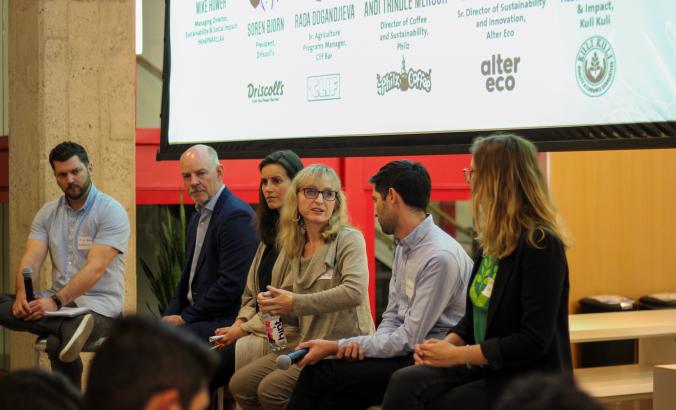3 big winners of the new low-carbon age

After much buildup, theCOP21 conference in Paristurned out to be a big win for people on Planet Earth. For the first time, the international community agreed to keep a global temperature rise well below 2 degrees Celsius this century, and to drive efforts of a 1.5 C limit above pre-industrial levels.
While the agreement won’t deliver all the emissions reductions needed, it provides a framework to ramp up ambition over time: a transparent system for reporting and review; regular assessments of progress; and strengthening commitments every five years.
The fossil fuel industry is the clear loser, as it will have a diminished role in a lower-carbon world. Around 75 percent of known fossil fuel reserves must be kept in the ground if the world is to avert the worst effects of climate change, according to theEarth League集团的科学家和经济学家。
Interestingly, several of COP21's corporate sponsors had direct ties to the fossil fuel industry, according to Corporate Accountability International. Still, the fossil fuel industry didn't appear to hold sway over leaders gathered in Paris.
The Paris Agreement sent a signal that the fossil fuel industry’s days of dominance are numbered, but the writing already has been on the wall. U.S. coal is on the decline, and now it won’t find a second life in developing countries. Likewise, Big Oil is facing problems — during the second quarter, Exxon and Chevron eachpostedthe worst quarterly results of this decade, due to declining oil and natural gas prices.
But the Paris Agreement also produced many winners. By taking actions that help ensure our planet remains habitable for generations to come, we all win. As does the economy; low carbon technologies could provide $5 trillion to $10 trillion of business opportunities andmillions of jobsby 2030, according tothe WBCSD's Low Carbon Technology Partnershipsinitiative.
Here are three sectors set to win big:
1. Renewable energy
The obvious winner from COP21 — solar, wind and other renewable energy technologies—will be in high demand in the coming decades, as they constitute a key component of the international effort to cut carbon emissions. With energy contributing around 35 percent of global emissions, according to the EPA, solar, wind and biofuels stand to gain much in a low-carbon world.
But renewables still only account for around 10 percent of the global energy supply, according to research firmSanford C. Bernstein, and most of that from hydroelectric power. Solar and wind account for 1.6 percent of total energy. In other words: We've got a long way to go before we can rely on renewables for all of our energy needs. But as COP21 signals to investors that renewables are the future, investment in these clean technologies is set to grow.
New investment could unlock opportunities to expand solar in the developing countries of the global South. SunPower CEOTom Werner toldThe New York Times that the Paris Agreement would help open investment taps for Africa and India, where access to capital for large projects has been limited. The sheer number of countries participating means that new solar markets can open up.
The wind industry also has won big thanks to the Paris Agreement. GE and Siemens, two major makers of wind turbines, are likely to see business boom as new investment in wind power proliferates in the next couple of years.
2. Energy storage
A lack of advanced energy storage capabilities is one of the biggest barriers to large scale solar and wind energy adoption, and overcoming this will be high on the post COP21-agenda. The sun isn’t always shining and the wind isn’t always blowing, which is why long-lasting, quickly recharging batteries need to be developed.
Elon Muskmade headlinesearlier this year when he unveiled the Powerwall, an advanced home battery. The flat wall-mounted package that provides 10 kWh of storage will sell for $3,500, storing solar energy and allowing customers to cache grid electricity from non-peak periods to use during peak times.
A larger version intended for utilities is the 100 kWh Powerpack, a scalable module that can go up to gigawatt levels at the $250 per kWh price point. Both are set to begin production next year atTesla’s Gigafactoryin Nevada.
3. The IT sector
Information communication technologies—including smartphones, networked sensors and smart grids—can helpdecarbonizethe energy sector by allowing scientists to model climate impacts,create smarter citiesand transform factories. And these technologies could generate over $11 trillion in economic benefits per year by 2030, according to recent research by the Global e-Sustainability Initiative and Accenture.
巴黎协定,对t的需求ech tools for decarbonization only will strengthen. Accurately reporting national emissions is a key provision of the agreement, which information tech can facilitate.
TakeENGIE Insight'scarbon management software, which helps companies approach carbon management from a variety of perspectives, depending on the drivers that affect their business. Likewise,Thinkstep’senterprise software for sustainable performance management builds upon a singular data and analytics foundation that connects to other IT systems, which companies can use for carbon benchmarking, best-practice sharing and impact assessments.




